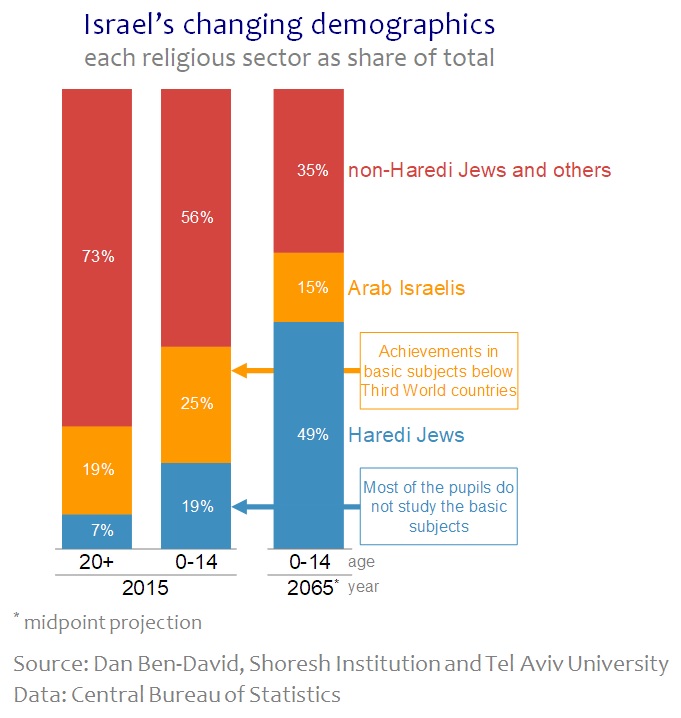Israel’s “Natural” Coalition Partners, and their Education Dan Ben-David A
question for those Israelis who plan to vote this coming April: When the Left
and the Right state that they refuse to sit together in a government, who are
the “natural” partners that they will prefer, and what will be the price of
their choice? From June 1977 through
April 2019, the ultra-Orthodox (Haredi) political parties have been a part – in
one constellation or another – of every Israeli government except two (roughly
39 of the 42 years). The short-term
price is low: quiet on the peace/territories front. The long-term price is terminal, for them and
for us, if we don’t get our act together while it is still possible to do so. Israel
is the only developed country in the world that allows parents to deprive their
children of the basic right to a core curriculum. Nearly all Haredi boys do not study the core
curriculum after eighth grade, and what they do study until eighth grade is
minimal, at best (no science, no English and mathematics at very rudimentary
levels). While this was once sufficient
in the less-developed Israel, with over 80 percent of the Haredi men employed
in the 1970s, the demand for such individuals in a modern economy has been
nearly identical to the demand for completely uneducated men. As a result, the employment rates of both
groups have dropped like a rock over the decades, temporarily rising in recent
years as a result of major cuts in welfare benefits. Israel
is a country enamored of short cuts and cutting corners – a trait that our
politicians have brought to an art form.
The Haredim have cultivated a conventional wisdom that they have
phenomenal study habits which can help them overcome all deficiencies very quickly. The response of the non-Haredi politicians
has been the easy route: no need for them to study what they need as children,
let’s give them the type of colleges that they insist on as adults, regardless
of their quality. An increase in the
number of Haredi students from 4,000 in 2009 to almost 10,000 today would
seemingly appear to corroborate this line of reasoning. But
if you don’t study much, you don’t know much.
The extraordinary dropout rates of the Haredim from academia are
unparalleled in Israel. Since 2004,
there has been no change in the very low share of prime working age Haredi men
with an academic degree (there has been a very slight increase among Haredi
women over the past three years). The
percentage of Haredim with an academic degree in the United States – where they
are not allowed to circumvent the core curriculum – is twice the percentage in
Israel. It is possible to be a Haredi
rabbi and to study at a serious university (there is no less an example than
the Lubavitcher Rebbe). Fertility
rates among Haredim, which fell after the massive cuts in welfare assistance at
the beginning of the 2000s, have been steadily rising over the past decade and
have eclipsed the seven-children-per-woman mark. The quickness of the demographic changes that
Israel is undergoing is captured in the graph.
Today, 7 percent of the adults and 19 percent of the children are
Haredim. According to the Central Bureau
of Statistics, in two generations, about half of Israel’s children will be
Haredim. If our politicians find it
difficult to create a government without them today, does anyone think that it
will become easier to change direction in the future? 
When
20 percent of the population paid 92 percent of all income tax revenues in 2017
(an increase from the 83 percent that they accounted for in 2000), it would be
a good idea if each voter asks his representatives the following: If the
Haredim do not receive a first world education immediately, who will carry this
country on their shoulders when the Haredim grow up – and what do you plan to do
about this after the April election? |